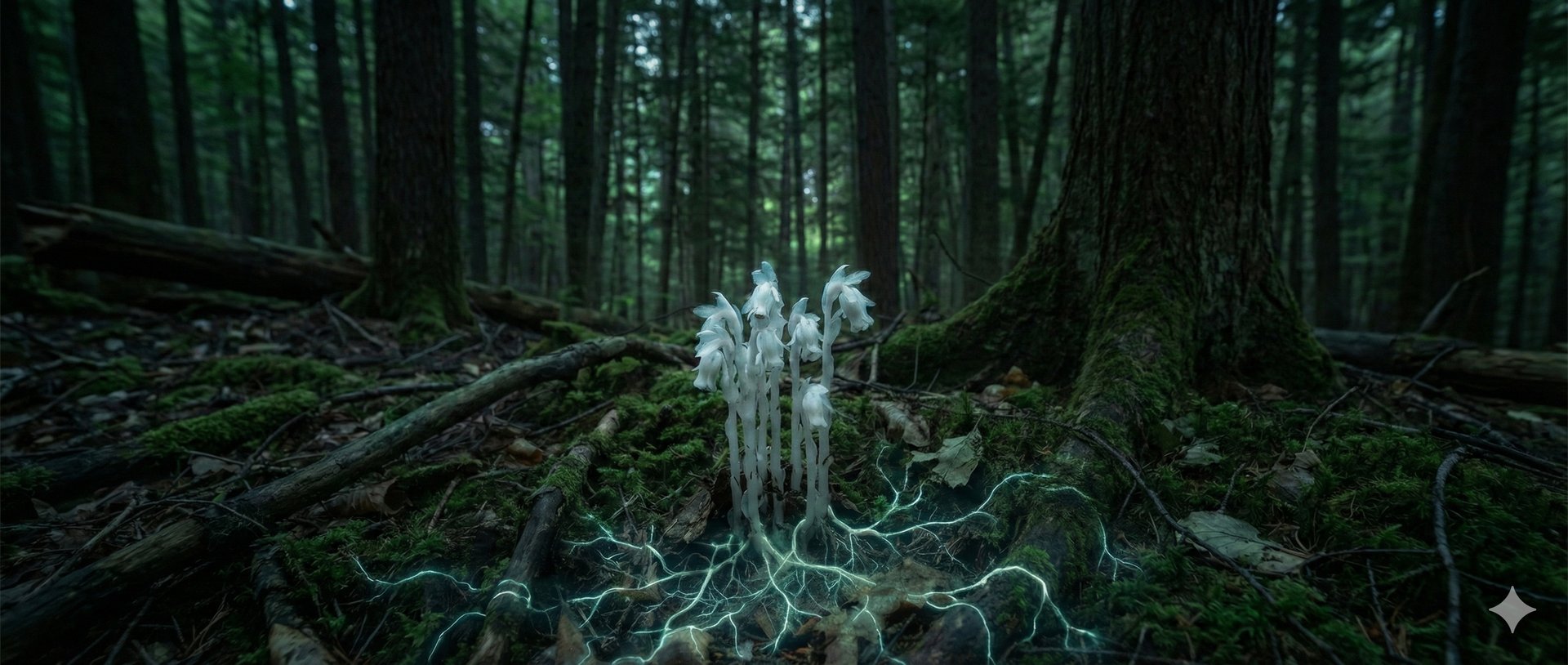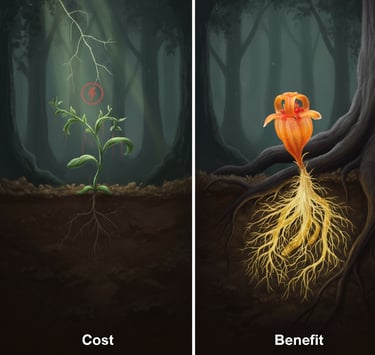
The Ultimate Evolutionary Trade-Off: A "Cost-to-Benefit" Analysis of Shedding Photosynthesis
The vast majority of plants live by the rules of photosynthesis: build chlorophyll, capture sunlight, and pay your own way. Yet, in the darkest recesses of the forest floor, a fascinating group of plants—the mycoheterotrophs (MHs)—has shredded the rulebook. They’ve fully abandoned photosynthesis, trading sunlight for stolen fungal carbon.
MCC
Mycelial Climate Council
10/23/20253 min read


Why would a plant shed its most fundamental trait? The answer lies in a precise evolutionary cost-to-benefit analysis tailored to the extreme low-light niche.
The vast majority of plants live by the rules of photosynthesis: build chlorophyll, capture sunlight, and pay your own way. Yet, in the darkest recesses of the forest floor, a fascinating group of plants—the mycoheterotrophs (MHs)—has shredded the rulebook. They’ve fully abandoned photosynthesis, trading sunlight for stolen fungal carbon.
Cost: What Mycoheterotrophs Give Up
Shedding photosynthesis means losing the primary engine of life, incurring several major biological costs:
Loss of Autonomy: The plant becomes completely dependent on a tripartite relationship involving the fungal network and the host tree. Fitness is entirely linked to the survival and function of two other partners.
Why It Matters: Zero control over its own carbon supply.
Loss of Free Energy Input: The plant loses access to direct energy from the sun (a free and abundant resource).
Why It Matters: It must rely entirely on complex, pre-processed organic compounds provided by the fungus, requiring specialized, carbon-extraction root structures.
Increased Specificity: Mycoheterotrophs exhibit highly specific relationships with narrow lineages of fungi (e.g., specific Russula or Glomerales groups).
Why It Matters: This limits geographical range and habitat flexibility, making the plant vulnerable if its preferred fungal lineage declines locally.
In essence, the MH plant trades a generalist, self-sufficient energy strategy for a specialist, highly dependent strategy.
Benefit: What Mycoheterotrophs Gain
The decision to become a "cheater" is justified only if the benefits of stealing outweigh the costs of photosynthesis in the plant's specific environment.
The Final Calculation: A Specialist's Success
The ultimate reason mycoheterotrophs exist is that for a small plant in a dark forest, the cost of manufacturing carbon is demonstrably higher than the cost of stealing it.
The Final Cost-Benefit Equation
The mycoheterotroph is an evolutionary specialist that has perfected resource allocation, dedicating minimal energy to infrastructure and maximum effort to securing the most reliable source of carbon and nutrients in its specific, resource-scarce niche. It’s a parasitic success story that showcases evolution's ability to capitalize on even the most intricate biological network.

1. The Carbon and Energy Efficiency Gain
In the low-light understory, the single greatest cost is building and maintaining the massive protein and pigment machinery required for photosynthesis:
Savings on Machinery: By becoming achlorophyllous (non-green), the plant avoids building and maintaining high-cost photosynthetic organs (chloroplasts, chlorophyll, leaves, stems). This frees up precious energy and nutrients (especially Nitrogen) that would otherwise be locked into unproductive, light-starved leaves.
Bypassing the Bottleneck: Fixed carbon is often the most limiting resource for growth in the dark forest. By tapping into the fungal network, the MH plant accesses the carbon stream after the host tree has invested the energy to fix it, essentially getting a high-energy, pre-packaged carbohydrate and lipid meal.
2. Strategic Resource Acquisition
The strategic nature of the relationship provides a critical evolutionary advantage, as highlighted by the Gomes et al. (2022) study:
Reliable Supply Chain: By preferentially targeting highly connected (keystone) fungi, MHs minimize the risk of carbon shortage. A highly connected fungus is backed by multiple photosynthetic trees, creating a buffered, redundant supply chain. It’s the difference between relying on one local shop and having access to a major trade network.
A Nitrogen Advantage: MHs often show isotopic signatures (especially high δ15N - is a measure of the ratio of the two stable isotopes of nitrogen: 15N (the heavier, rarer isotope) to 14N (the lighter, common isotope) suggesting they acquire nitrogen in an organic form (e.g., amino acids) from the fungus. This provides a high-quality, pre-processed Nitrogen-rich diet that is highly energy-efficient compared to the typical nutrient uptake mechanisms used by autotrophs.
3. Escape from Above-Ground Competition
By abandoning leaves, MHs can spend most of their lives as tiny rhizomes (underground stems), emerging only briefly to flower and fruit.
Predator and Herbivory Escape: Most of the plant's biomass remains safe underground, shielded from herbivores and fire.
Habitat Specialization: This strategy allows them to thrive in deep, old-growth forests—habitats too dark or nutrient-limited for many green understory competitors.


